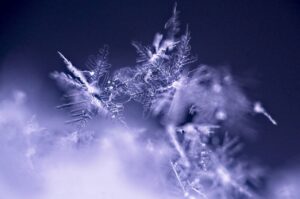By Rodaportal
INTRODUCTION
When we think of snow, our minds conjure images of pristine landscapes, icy mornings, and the enchantment of winter festivities. The cold that blankets the world often obscures the beauty it holds, but when those delicate snowflakes descend, an ethereal transformation takes place. The world hushes, and softens, and an invisible cocoon envelops you, instilling a sense of peace and tranquillity.
Yet, have you ever wondered why snow, despite being composed of transparent ice crystals, appears so brilliantly white? Let’s delve into the fascinating science behind the colour of snow and unravel the mysteries of its crystalline beauty.

Snow, in its essence, is a collection of countless tiny ice crystals bound together to form the delicate flakes that grace our surroundings. Individually, these ice crystals are transparent, but their collective arrangement turns the landscape into a winter wonderland. As sunlight filters through the atmosphere, the varied facets or “faces” of the ice crystals reflect the light in myriad ways, creating the illusion of a pristine white canvas.
The magic doesn’t end there – did you know that every snowflake is a six-sided masterpiece? Formed from water molecules that intricately fit together in a hexagonal pattern, each snowflake takes a unique journey from the sky to the earth, encountering slightly different atmospheric conditions. This results in an exquisite array of snowflake shapes, ranging from prisms to delicate needles.

Consider this: a snowflake takes about one hour to make its descent to the ground. According to the Met Office in the United Kingdom, snowflakes typically fall at speeds ranging from 1 to 4 mph, with the largest, heaviest ones reaching speeds of up to 9 mph. Picture the dance of these intricate crystals, each with its distinct path, creating a mesmerizing display as they journey earthward.

Now, let’s dispel a common misconception: it doesn’t have to be freezing for snow to fall. While the air temperature must be below freezing for the transformation of water vapour into snow, persistent rainfall in temperatures as high as 6 °C can eventually cool the surrounding air enough for rain to transition into snow. It’s a testament to the dynamic interplay of weather elements that we often overlook.
As you revel in these revelations, consider the enchanting dance of snowflakes, the intricacies of their formation, and the surprising conditions that bring them to life. The next time you witness a snowfall, let this knowledge enhance your appreciation for the silent symphony unfolding before your eyes.

Curious for more? Dive deeper into the science and beauty of snow by watching my YouTube video, “Did You Know that Snow Isn’t White?” at this link: https://youtu.be/7M4GGe76ELk. Share your thoughts and any additional intriguing facts in the comments section below; I’m eager to hear from you!
